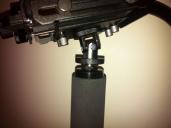
It allows to keep PV going, with more focus towards AI, but keeping be one of the few truly independent places.
-
Bought one for a laugh - will post results soon.
You can get yours also at http://www.amazon.com/Opteka-SteadyVid-Stabilizer-Camcorders-Supports/dp/B007FDE4Y8/
-
@Jive Thanks. I missed that. I haven't had a chance to use AE Warp stabilizer effect yet.
-
@jleo In at least one of those videos he does state that post stabilization was used, making his claim of "100% handheld" a bit misleading. Of course you don't need a steadicam if you're willing to spend the time rendering out the wobbles in post
-
I must have wasted a whole year fidgeting with stabilizers. This GH2 shooter Drew M, gets very steadycam like movement hand held:
Found the perfect must-have camera crane for the GH2 :) It appears at 1 min 50 sec
-
I have had it with stabilizers... I bought this thing off of eBay and tried forever to get it balanced. I got it balanced quite well and then placed it carefully on my couch. I came back and picked it up and it was all out of whack. I know these things are fidgety but I really don't have the time or patience for it. I am going to get a fig rig.
-
Unfortunately I didn't have time to to a video review before I had to return the Opteka sabilizer (borrowed it), but I wrote an email to the manufacturer with the following suggestions that might be of interest to you...:
"I have quite a bit of experience with all sorts of stabilizers so I decided to test your new SteadiVid Pro stabilizer. It's pretty good but a few small improvements could really make a big difference.
Weights: If you would create the smallest weight (the one with the rounded edges) with a female thread, there would be much more options for balancing and it would make it possible to balance for light cameras which is currently very difficult. In fact, it's very difficult to balance for the Panasonic GH2 which is a very popular camera among indie filmmakers.
The gimbal works pretty well for the most part put the week spot is the pan ball bearing. It isn't smooth enough and gets even worse when the handle isn't held perfectly vertical. This could easily be fixed by using a better bearing or even 2-4 bearing on a longer shaft that goes into the handle. Currently, it's very difficult to get footage without your footsteps showing as little left and right pans in the footage. This is a deal braker for me.
Also, use two thumbscrews in place of the machine screws that tighten down the "arc" (like the Merlin does). Currently, when you adjust the length of the arc, there's always play in it.
These small improvement would bring it on par with the Merlin and even make it better in some aspects.
If you have any questions or would like me to explain the issues in more detail, let me know...."
-
The 4 screws under the mounting plate allow you to remove the gimbal and handle section - the handle is re-moveable from the underside of the gimbal also.
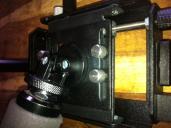
 photo.JPG640 x 478 - 132K
photo.JPG640 x 478 - 132K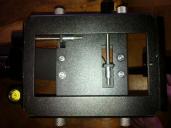
 photo.JPG640 x 478 - 143K
photo.JPG640 x 478 - 143K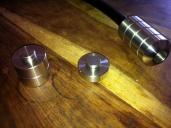
 photo.JPG640 x 478 - 141K
photo.JPG640 x 478 - 141K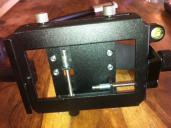
 photo.JPG640 x 478 - 140K
photo.JPG640 x 478 - 140K -
please provide more information about that "Robot" crane, it's crazy ...
-
The whole gimbal section is removeable from the baseplate also - let me have a coffee and I'll post some pics :)
-
forget the opteka! what on earth is that crazy animatronic motion tracking crane in that video review???
-
Toronto2 ... yes the "pan wheel" I mention is referred to by Opteka as the "thumb stabilizer" as shown in first unboxing video @ 3:19. Also shown directly above the handle and below the universal joint in the photo close-ups by gh2sound (above).
Cordvision ... can you show closeups of any screws that could allow the Opteka to be dismantled? (i.e. what is "screw assembled" and what is "cast" metal/plastic ? On the handle, stage and counter-balance adjustment knob.)
-
I'll be posting a review in a few days comparing it to the Merlin... Anything specific you would like me to look for?
-
@cp_from_oz , just want to clarify, the "pan wheels" you are talking about is the "thumb stabilizer" of first video @ 3:19?
-
Video posted by Oedipax (above) was done on older model Opteka Steadyvid "EX" not new "Pro" as can be seen from shadows of rig at 00:17 and 01:36 showing flat construction of spars, not rounded.
-
Following up on rambo's comment on tilting control that *** It's very easy to achieve the same [stable tilting] result using the "collar" with the Smoothee, similar to what would do with high cost commercial steadycam main shaft, one just has to practice.***
I have to disagree very strongly. The merlin and smoothee due to their light overall weight (i.e. incredibly low inertia) will always be extremely susceptible to pan/roll problems when tilting ... much more so than a heavy full-size commercial rig. The best analogy I have heard is comparing the inertia of a canoe v. that of an ocean liner. The baby stabilisers are the "canoes" ... transferring every little micro jolt and wobble from your fingers into your frame. The separate pan wheel of the Opteka/Blackbird/Wsclater design can significantly reduce the pan/roll problem when tilting if proper discreet pressure is applied to the pan wheel. Thus the Opteka could be well positioned to outgun the Merlin/Smoothee in terms of cost and tilt operating control, and the Blackbird on grounds of cost. (Other factors like gimbal smoothness, trim controls, size, transportability, ease of balance are obviously still to be considered.)
-
I got one to bring with me to places where I'm leery of bringing my Merlin - no sample footage yet, but... Pros: - Has an actual gimbal unlike some other budget stabilizers in which the gimbal is really a ball joint - Forward/back and left/right trim available which makes it easier to balance a DSLR - The camera mounting plate is decent
Cons: - While the camera plate sort of acts as a quick release plate, it's difficult to place it precisely back on the stabilizer in the same place as one had it last. Also, there is nothing included to mount it on a tripod (similar to what is included with the Merlin) - The counterweights are not nearly flexible enough (heavy, light, superlight). For my GH2 w/ 7-14mm on it, I wasn't able to get things balanced even with the bottom arm extended very far. To get balanced with the heavier weight, I had to nearly completely close the stabilizer and it's hard not to bump it with my arm. I'm planning to get a quick release to mount which should add some weight to the top - that'll probably help. - Gimbal is not as smooth as my Merlin. I might try lubricating it a bit more to see if it gets a little better.
Overall, it's better than I expected for something that cost less than 1/4 of what my Merlin cost.
-
It's very easy to achieve the same result using the "collar" with the Smoothee, similar to what would do with high cost commercial steadycam main shaft, one just has to practice. The trick is to get the rig balanced dynamically as well as statically.
-
Clarification of definitions re rambo comments on pan wheels: - Smoothee/Merlin does not have a "separate pan wheel". It has one 360 degree surface of contact ( i.e. a collar) around the three dimensional gimbal which directly affects all three axes of pan, tilt, roll. Any effort applied to tilt (however careful) is likely to affect roll and pan. Greater the effort to tilt or angle of tilt, greater the likely effect on other axes. The notch on the front and rear of the Smoothee operating surface (collar) does not provide any mechanical isolation. [The pan wobble effect in a shot is best shown up if you are walking towards a tall street sign, starting flat and attempting to pan up and hold the sign in centre of frame as you walk very close to the sign.] - A truly separate pan wheel is offered on Opteka Steadyvid Pro / Blackbird / Wsclater geometry whereby the pan wheel is mechanically separate from the universal joint which controls tilt and roll. By applying slight or full pressure to the pan wheel, you canmechanically dampen and/or isolate the pan axis.
-
There is a tiny thumb notch in the Smoothee pan wheel that when handled correctly, can prevent pan rotation. Same at the front of the wheel, there is a surface provided to place your forefinger.
Once these affordable stabilizers are balanced correctly, the rest is up to the skill of the operator.
-
Same as Merlin and all designs with this build according to my terribly annoying director chum who's owned em all - as initially posted - for a laugh
-
""""Tilting when walking with the Smoothee for instance is almost guaranteed to have pan wobbles."""Not necessarily cp_from oz, the Smoothee also has a thumb and/or finger "wheel" > SteadyCam Smoothee and GF2.
No processing other than 1080>720 for vimeo upload.
-
In basic operation, as a complete amateur, but with help from a (real) Steadicam vet, I concur, vertically when balanced it holds up, but left and right - there is some movement, but that may be my utter noobness with the operation - as I said bought it for a laugh!
Howdy, Stranger!
It looks like you're new here. If you want to get involved, click one of these buttons!
Categories
- Topics List23,993
- Blog5,725
- General and News1,354
- Hacks and Patches1,153
- ↳ Top Settings33
- ↳ Beginners256
- ↳ Archives402
- ↳ Hacks News and Development56
- Cameras2,368
- ↳ Panasonic995
- ↳ Canon118
- ↳ Sony156
- ↳ Nikon96
- ↳ Pentax and Samsung70
- ↳ Olympus and Fujifilm102
- ↳ Compacts and Camcorders300
- ↳ Smartphones for video97
- ↳ Pro Video Cameras191
- ↳ BlackMagic and other raw cameras116
- Skill1,960
- ↳ Business and distribution66
- ↳ Preparation, scripts and legal38
- ↳ Art149
- ↳ Import, Convert, Exporting291
- ↳ Editors191
- ↳ Effects and stunts115
- ↳ Color grading197
- ↳ Sound and Music280
- ↳ Lighting96
- ↳ Software and storage tips266
- Gear5,420
- ↳ Filters, Adapters, Matte boxes344
- ↳ Lenses1,582
- ↳ Follow focus and gears93
- ↳ Sound499
- ↳ Lighting gear314
- ↳ Camera movement230
- ↳ Gimbals and copters302
- ↳ Rigs and related stuff273
- ↳ Power solutions83
- ↳ Monitors and viewfinders340
- ↳ Tripods and fluid heads139
- ↳ Storage286
- ↳ Computers and studio gear560
- ↳ VR and 3D248
- Showcase1,859
- Marketplace2,834
- Offtopic1,320
Tags in Topic
- stabilizer 44
- steadicam 39
- opteka 8






